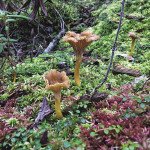Story and photos by Kate Watson
It was a normal hike. A rocky path leading uphill. Dense forest on either side of the trail. Unknown rustlings in the underbrush. Packs loaded with provisions and extra layers—and a dinner-plate sized tarantula scurrying across the beam cast by my headlamp. It was a dark and stormy night in Panama, and my friend Pete and I were climbing a volcano.
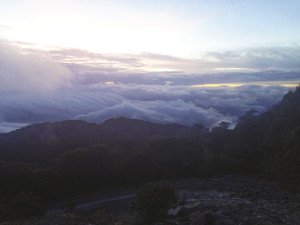
The peak of Volcan Baru in Chiriqui Province, Panama, is the country’s highest point at 11,398 feet. Probably best known for the Panama Canal (and the best palindrome: A Man, A Plan, A Canal, Panama!), Panama is the southernmost country in Central America, sharing borders with Columbia and Costa Rica. You’ll find the towering Volcan Baru in the far northwestern region of the country, just across the border, or about 21 miles, from Costa Rica. Since Panama is an isthmus (flashback to middle school geography: a narrow strip of land with sea on either side, linking two larger areas of land—in this case N. and S. America), if you venture to the very top of the volcano on a clear day you can look toward the horizon and see the Atlantic Ocean, then look over your shoulder to see the Pacific stretching endlessly in the opposite direction.
The guidebooks warn that the trip up Volcan Baru is best undertaken with a guide, and that it’s not for the faint of heart. The hike gains 7,498 feet of elevation over its 13 kilometers—that’s 937 vertical feet per mile. In short: it’s really steep. The other option is to hire a jeep. Although the path is rocky and deeply rutted, a jeep can handle the trip. For about $125 per person you can save yourself the trouble of walking and instead endure an incredibly bumpy, jolting two-hour ride in a 4×4 to reach the top with the rising sun (and then another uncomfortable trip down). This option did not appeal to me. In these situations, it seems the view is truly sweetest if it’s earned the hard way.
Fortunately for me, Pete, a friend from high school, happened to be passing through Panama when I was visiting. He had summited the volcano the previous week, and was willing to undertake the trek again. Generally, the goal is to set off at midnight and complete the hike in around six hours. This will put you at the top just in time for sunrise. With this plan in mind, and the unlikelihood of flagging down a taxi at midnight a few miles outside of Boquete, we arranged for a midnight pickup with plans of being whisked the nine miles to Volcan Baru Nacional Parc, where the hike would begin. At 12:15 am we were still waiting.
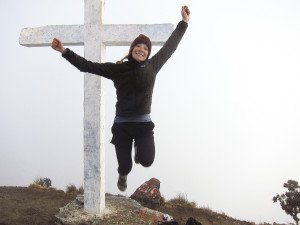
“Well, how long do we wait?” I asked, ever the worrier. I was already sweating bullets—both due to the air temperature and the storied reputation of the hike itself. A lengthy pre-hike warm-up was not in my game plan.
“Let’s wait a little longer and then start walking. I’m sure we’ll run into a taxi along the way,” Pete said, unconcerned.
At 12:30 a.m. the walk began. Sure enough, we were able to flag down a taxi a mile or two in, and we were on our way. To me, it felt like an inauspicious way to start a day that would be characterized by…lots of walking. As the taxi climbed out of the valley toward the park, the dark clouds massed over Boquete were illuminated by flashes of lightning. Thunderstorms were predicted, but rain wasn’t falling yet. At the park entrance the taxi driver dropped us on the side of the road. We gathered our packs, passed by the ranger station (closed for the night), and started walking. It was dark and hot. On a normal night I would be deep into my REM sleep cycle.
The next four and a half hours were one foot in front of the other over talcum powder sand and loose fist-sized rocks. With frequent water breaks and ever steeper hills around the next corner, our sphere of existence was restricted to the task at hand: moving upward. In addition to the scuttling, enormous tarantula, we saw oil spatterings from doomed vehicles that couldn’t quite clear the large rocks, heard the amplified rustlings of critters on their nocturnal constitutions, and every so often, the vibrant colors of a tropical flower would flash as our headlamp beams swept past. With our visual fields limited to a tiny slice of light, the experience was surreal.
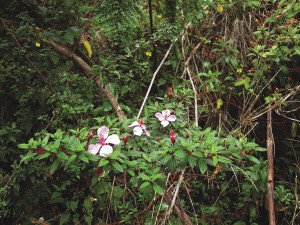
“I’ve never seen stars like this! Even in Alaska or the Boundary Waters—they’re amazing!” I said, stumbling over yet another rock while gawking at skies vaster and blacker than I’d ever seen.
Even though I couldn’t see him, I knew Pete was smiling. He had told me about the stars, and I didn’t believe they could possibly be that spectacular. They were.
We made good time going up, allowing us to steal an hour of fitful, teeth-chattering sleep near the top. The barren, rocky ground of the primitive camping area was far from a featherbed, and the alarm went off all too soon—time to tackle the last kilometer and catch the sunrise. A few rocky switchbacks brought us to the fenced site of the mountaintop communications towers, then we scrambled up a crooked footpath and were at the tip top of the volcano. As I stood at the foot of the large concrete cross marking the spot, Pete called “Right now you’re the highest person in Panama!”
Both the elevation and adrenaline made this statement very true. Looking down on a broad swath of clouds and the transmission towers, we really were on the top of the world. Strong winds sent a thick mist streaking past, and I was glad for the absurd number of layers I had packed. The clammy heat from the beginning of the hike, almost 7,500 feet below us, was a distant memory.
Due to the cloudy weather, no jeeps filled with well-rested, sunrise-viewing tourists showed up, but shortly after we arrived, a group of three Panamanians joined us. One was a local man in his twenties and two friends who’d come up the other side of the mountain. The man said he’d summited the volcano no less than 12 times, and it was his favorite spot in the country. But, he claimed, his accomplishments didn’t compare to other locals who worked as guides—one had been up the volcano more than 50 times.
After marveling at the clouds, the view, and the accomplishment of hiking up the mountainside (plus a celebratory Snickers bar) it was time to head down. The hike back was surreal in a different way. Stripping off layers as we descended and the temperature rose, I was awestruck to see the steep terrain in broad daylight.
“It’s a good thing it was so dark on the way up—luckily I had no idea what we were in for.” I said. “And I can’t believe you were willing to do this twice.”
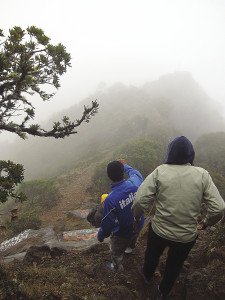
“Not a problem,” Pete said, as if he hiked up volcanoes every day. On his first trip, he and his group reached the top to find clear skies. “Even though we didn’t see both oceans, there’s still something magical about seeing above the clouds,” he said. I agreed.
About halfway down, the forest thickened, and Pete told me about a bucket list bird-watching opportunity.
“I haven’t seen one yet, but there are quetzals here and this is their mating season,” he said. “Listen for this.” And he proceeded to make a noise like a loudly whimpering dog. Quetzals were a sacred bird to the indigenous cultures, he explained. The tail feathers were harvested for the headdresses of Mayan and Aztec nobility, and their inability to survive in captivity made them a symbol of liberty. Sure enough, a little further down the trail, the odd call echoed through the forest. We froze and scanned the canopy for the brightly colored bird. After hearing a few more calls, we saw a motion in the leaves, and the majestic bird flew by—its tail streamers clearly visible as it headed deeper into the woods.
Energized by this sighting we headed further down the volcano, knees complaining as rocks and powdery sand shifted underfoot. With sore, tired muscles, unstable terrain, and persistent gravity (I only fell once) the going was almost tougher than it had been on the way up. Near the bottom, it started to rain. We stopped on the way out of the park to pay our entrance fee ($5 each), and inquired about transportation back to town. There was a bus stop only about five minutes down the road, the ranger said, and we were delighted at the thought. After what turned out to be 15 minutes of walking (downhill, again), well-soaked and exhausted, we huddled in the shelter to wait.
“How do you feel about hitchhiking?” Pete asked, after about an hour.
Five minutes later, we were in the back of an obliging farmer’s pickup, still getting wet, but at least moving forward without the use of our own tired legs. After the driver dropped us in Boquete, we stopped at a bakery for an overdue lunch. It would have been easy enough to catch a taxi back to the guesthouse, but we decided the honorable way to finish the 15-hour adventure was on foot. As we walked along the river, we could see the distant Volcan Baru, its peak obscured by clouds. But we knew it was up there, towering over Panama, and we had been too. In the land of free-range tarantulas and the resplendent quetzal, we really had been on top of the world.



